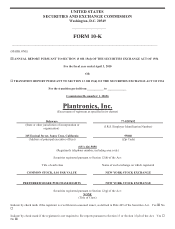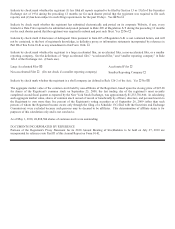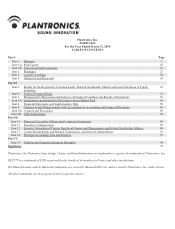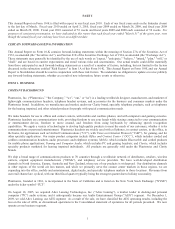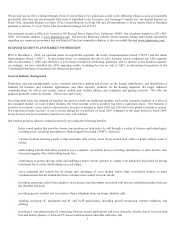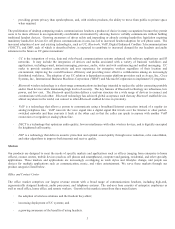Plantronics 2010 Annual Report Download - page 11
Download and view the complete annual report
Please find page 11 of the 2010 Plantronics annual report below. You can navigate through the pages in the report by either clicking on the pages listed below, or by using the keyword search tool below to find specific information within the annual report.3
· providing greater privacy than speakerphones, and, with wireless products, the ability to move from public to private space
when required.
The proliferation of desktop computing makes communications headsets a product of choice in many occupations because they permit
users to be more efficient in an ergonomically comfortable environment by allowing them to verbally communicate without holding
traditional handset devices. Growing awareness of driver safety and impending or already existing hands-free legislation requiring
mandatory hands-free devices for cell phone communications in cars, has led to increased headset adoption for cell phone users. The
increased adoption of new and existing technologies, such as UC, Bluetooth, VoIP, Digital Enhanced Cordless Telecommunications
(“DECT”), and DSP, each of which is described below, is expected to contribute to increased demand for our headsets and audio
solutions in the future as UC gains momentum:
· UC is the integration of voice, data and video-based communications systems enhanced with software applications and IP
networks. It may include the integration of devices and media associated with a variety of business workflows and
applications, including e-mail, instant messaging, presence, audio, video and web conferencing and unified messaging. UC
seeks to provide seamless connectivity and user experience for enterprise workers regardless of their location and
environment, improving the overall business efficiency and providing more effective collaboration among an increasingly
distributed workforce. The adoption of our UC solution is dependent on major platform providers such as Avaya, Inc., Cisco
Systems, Inc., International Business Machines Corporation (“IBM”) and Microsoft Corporation to implement UC programs.
· Bluetooth wireless technology is a short-range communications technology intended to replace the cables connecting portable
and/or fixed devices while maintaining high levels of security. The key features of Bluetooth technology are robustness, low
power, and low cost. The Bluetooth specification defines a uniform structure for a wide range of devices to connect and
communicate with each other. Bluetooth technology has achieved global acceptance such that any Bluetooth enabled device,
almost anywhere in the world, can connect to other Bluetooth enabled devices in proximity.
· VoIP is a technology that allows a person to communicate using a broadband Internet connection instead of a regular (or
analog) telephone line. VoIP converts the voice signal into a digital signal that travels over the Internet or other packet-
switched networks and then converts it back at the other end so that the caller can speak to anyone with another VoIP
connection or a regular (or analog) phone line.
· DECT is a technology that optimizes audio quality, lowers interference with other wireless devices, and is digitally encrypted
for heightened call security.
· DSP is a technology that delivers acoustic protection and optimal sound quality through noise reduction, echo cancellation,
and other algorithms to improve both transmit and receive quality.
Markets
Our products are designed to meet the needs of specific markets and applications such as offices (ranging from enterprise to home
offices), contact centers, mobile devices (such as cell phones and smartphones), computer and gaming, residential, and other specialty
applications. These markets and applications are increasingly overlapping as work styles and lifestyles change, and people use
devices for multiple applications such as communication, music, and video entertainment. We serve these markets through our
product categories listed below.
Office and Contact Center
The office market comprises our largest revenue stream with a broad range of communications headsets, including high-end,
ergonomically designed headsets, audio processors, and telephone systems. The end-user base consists of enterprise employees as
well as small office, home office, and remote workers. Growth in this market comes from three main factors:
· the adoption of wireless solutions and the freedom they allow;
· increasing deployment of UC systems; and
· a growing awareness of the benefits of using headsets.





